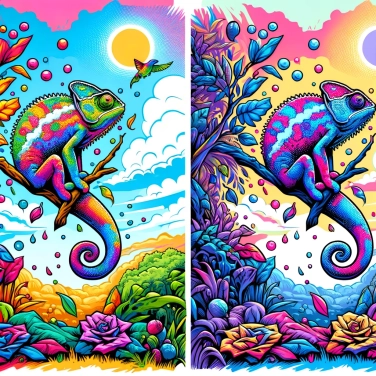Chameleons change color primarily for communication, camouflage, temperature regulation and reacting to emotions.

Chameleons have special cells under their skin called chromatophores. These cells contain different colored pigments that they spread out or concentrate depending on the situation. The most important chromatophores are melanophores (dark pigments) and iridophores (reflective crystals). When they change their arrangement, the reflected light varies and voila! the chameleon changes color. These reactions are triggered by the nervous and hormonal systems, depending on the environment, temperature, or mood. It's a bit like they are adjusting an internal switch and deciding on the look to display according to their needs.
The colors of chameleons are like true visual signals intended for their peers. When a chameleon adopts bright or contrasting colors, it is often to mark its territory, impress a rival, or attract a mate. For example, two males competing for the same territory engage in a real chromatic duel where the one displaying the most intense colors usually shows a more pronounced dominance. Conversely, more subdued or dull shades indicate submission or tranquility, allowing the chameleon to avoid unnecessary conflicts. These simple variations facilitate social communication without the need for physical confrontation at every encounter.
Chameleons change their colors also to manage their body temperature. When it's cold, they generally adopt darker colors, which allows them to absorb heat from the sun more easily and warm up quickly. Conversely, when it's hot, they become lighter, reflecting light rays and avoiding overheating. It's a bit like wearing a black sweater to capture heat, or a white t-shirt when they're hot. Handy, right? These changes occur thanks to special layers of their skin called chromatophores, which can expand or contract to influence the intensity of the displayed color and thus thermal regulation.
Chameleons clearly convey their emotions through their colors. When they are in a state of stress, such as encountering a predator or an impressive rival, their colors become intense, with strong and visible contrasts. In contrast, a calm and relaxed chameleon generally displays more neutral or uniform colors, often leaning towards green, brown, or other soft hues. A disturbed or unwell female may display very bright colors with recognizable patterns to signal her need for personal space. These changes simply and practically show the "state of mind" of a chameleon, thus facilitating its interactions with others of its kind.
The skin of chameleons contains nanocrystals that, by altering their arrangement, reflect light differently, thus enabling these extraordinary color changes.
Some chameleons can completely change their color in just 20 seconds thanks to their pigment cells called chromatophores.
Chameleons have a limited color palette depending on their species: each chameleon can only display certain predetermined colors, which means they cannot take on all the colors they encounter in their environment.
Researchers have discovered that male chameleons often adopt more vibrant colors when confronted with a rival, which clearly represents a way to display their dominance.
In general, a chameleon tends to adopt lighter colors when it sleeps. This is due to the decrease in external stimuli and the absence of social signals to convey during its sleep. This phenomenon makes chameleons often easier to notice in the dark.
Yes, color changes in chameleons can be remarkably quick. A chameleon can change its appearance in just a few seconds in response to strong emotions or sudden changes in temperature.
The mechanism of color change is natural and does not tire the chameleon. This process involves the movement and modification of specialized cells called chromatophores or iridophores. This mechanism requires very little energy, allowing chameleons to change color numerous times throughout the day without any significant issues.
No. The capabilities vary greatly among species of chameleons. Some species, like the panther chameleon, can display a wide range of vibrant colors, while other species have a much more limited palette with rather subtle variations.
No, contrary to popular belief, chameleons do not systematically copy the colors around them. Their color palette mainly depends on their species, emotional state, body temperature, and social or environmental signals. For example, certain bright hues are primarily used to attract attention or impress a potential mate.

0% of respondents passed this quiz completely!
Question 1/5